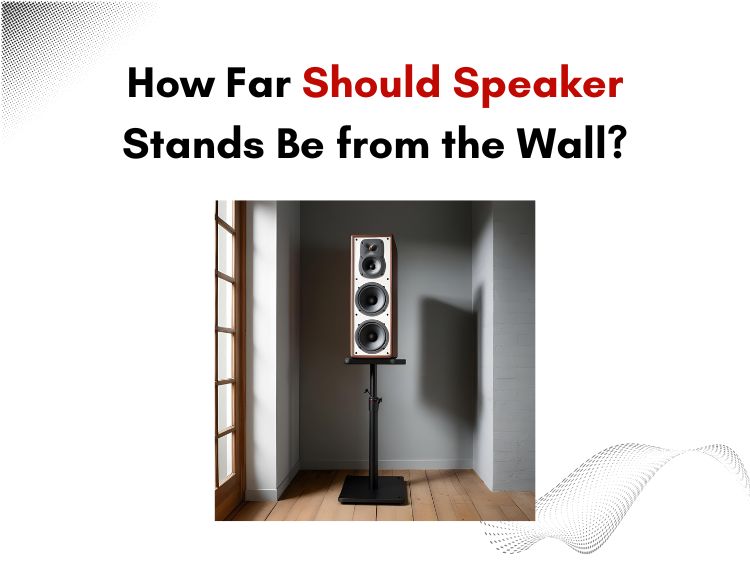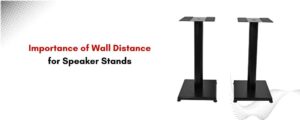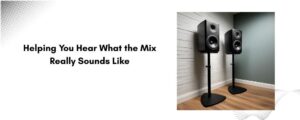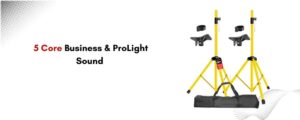When setting up your audio environment—whether it’s for a home studio, DJ gig, or home theater—one critical detail often overlooked is how far speaker stands should be from the wall. It may seem minor, but this spacing plays a significant role in achieving accurate sound reproduction, balanced bass, and clear stereo imaging.
In this guide, we’ll break down the ideal placement distance, explain the acoustic principles behind it, and recommend high-quality speaker stand options from trusted names like 5 Core, 5 Core Business, and PLS.
Importance of Wall Distance for Speaker Stands
1. Minimizing Boundary Interference and Bass Buildup
The most significant reason to keep speaker stands away from walls is to prevent bass exaggeration caused by boundary interference. When speakers are placed too close to a wall—especially the rear wall—the low-frequency sound waves reflect off the surface and interact with the original signal.
This can lead to:
- Bass overemphasis: You might hear a boomier sound that distorts the original mix.
- Standing waves: These are resonant frequencies created when direct and reflected sound waves reinforce or cancel each other out.
- Phase cancellation: Some frequencies might get muted or misrepresented due to destructive interference.
Acoustic Fact Check: According to the BBC Research Department and studies on small room acoustics, reflections from walls significantly affect low-frequency response, often leading to +6 dB boosts in the 80-200 Hz range if speakers are placed directly against a wall.
In other words, keeping your speaker stand and speaker at least 2 to 3 feet from any wall allows sound waves to develop naturally before they hit a reflective surface, giving you a flatter and more accurate frequency response.
2. Enhancing Stereo Imaging and Soundstage Clarity
When sound from both speakers arrives at your ears without early reflections, your brain can localize instruments more precisely, resulting in a more immersive stereo field. But when a speaker is too close to a wall, reflected waves reach your ears too quickly, mixing with the direct sound and smearing stereo imaging.
Here’s what this affects:
- Instrument placement: Instruments may seem like they’re “blended” rather than separated.
- Clarity: Especially in reverb tails, background vocals, or panning effects.
- Fatigue: Your ears work harder to decode the source of sounds in a messy stereo image.
By placing your tripod speaker stand at a measured distance from walls (and using proper toe-in), you minimize these reflections, allowing cleaner stereo separation and better depth perception.
3. Reducing Reflections and Echoes
Not all reflections are created equal. Wall reflections are specular—they reflect sound waves in specific directions, unlike diffusive surfaces which scatter sound. Close proximity to walls increases the risk of:
- Comb filtering: A hollow, flanging effect caused by overlapping sound waves.
- Midrange distortion: Mid-frequencies bounce more aggressively off hard walls.
- Early reflections: Reflections that reach the ear almost simultaneously with the direct signal, damaging imaging and clarity.
To combat this, placing your speaker stand and speaker further into the room gives time for reflections to decay or be absorbed by treatment before affecting your listening zone.
4. Improving the Performance of Acoustic Treatment
Most home studios or listening rooms use foam panels, bass traps, and diffusers. But their effectiveness drops if speakers are too close to untreated walls. Sound doesn’t get a chance to interact with those treatments as intended.
By spacing the durable stand away from the wall, you:
- Allow bass traps behind the speakers to do their job.
- Give time for first reflections to be absorbed by panels on the side and back walls.
- Maintain a controlled decay time for different frequencies.
5. Helping You Hear What the Mix Really Sounds Like
Whether you’re a DJ, home producer, or audiophile, the whole point of investing in a high-quality speaker stand—like the 5 Core tripod speaker stand—is to reproduce sound accurately. But wall reflections and close proximity distort this accuracy.
Imagine this:
- You mix a track with boomy bass due to close speaker placement.
- You compensate by cutting bass in the mix.
- When played elsewhere (car, club, streaming), the track sounds thin—because your monitoring environment was misleading.
Correct spacing ensures what you hear is what your audience hears. It’s the foundation of honest sound reproduction.
The Ideal Distance from the Wall
General Recommendation
- Rear wall: At least 2 to 3 feet (60 to 90 cm) from the back of the speaker.
- Side walls: 2 to 3 feet minimum, with symmetry on both sides.
This spacing allows natural decay of bass frequencies and cleaner reflection paths for mids and highs.
For nearfield monitors in small rooms, 1.5 feet may be acceptable, but experiment by listening critically and adjusting gradually.
Getting the Right Speaker Stand
Speaker placement is only as good as the stand supporting it. A wobbly, fixed-height stand will limit your positioning options. That’s why we recommend investing in a durable stand like the tripod speaker stand from 5 Core.
Why Choose 5 Core?
5 Core is a global leader in sound equipment manufacturing, with over three decades of innovation. Their speaker stand collection offers:
- Height adjustability up to 72 inches
- Heavy-duty steel construction for stability
- Non-slip rubber feet for better grip
- Foldable design for portability
- High weight capacity for professional speakers
This tripod speaker stand is engineered for both studio monitors and DJ gigs, ensuring that your speakers are perfectly aligned with ear level, and far enough from the wall to minimize reflections.
Other Trusted Options: 5 Core Business & PLS
If you’re looking for volume purchases or B2B deals, 5 Core Business is ideal for retailers and pro-audio suppliers. Their pricing is competitive for bulk orders, and they offer prompt delivery and business-level customer support.
Alternatively, PLS (Pro Light & Sound) provides an excellent retail experience for those in the entertainment and events industry. Their curated selection ensures that only proven, high-performance equipment makes it to your setup.
Tips for Placement and Setup
1. Toe-In the Speakers
Angle the speakers inward slightly (toward your listening position) to improve high-frequency dispersion. This helps maintain clarity across the stereo image.
2. Measure the Triangle
For stereo setups, the distance between the two speakers should be equal to the distance from each speaker to your listening position—forming an equilateral triangle.
3. Avoid Obstructions
Don’t place furniture or acoustic panels between your speaker and the listener. This can interfere with high frequencies.
4. Isolate the Stand
Use foam pads or isolation pads between the speaker and the stand plate to reduce vibration transmission.
Real-World Feedback: Customer Reviews
Evan R., Home Studio Producer
“The 5 Core tripod speaker stand is a game changer. I finally got the right ear height and moved my monitors 2.5 feet from the wall. The bass cleaned up instantly. Highly recommend it for anyone serious about sound.”
Trina J., DJ & Event Organizer
“I got the pair from 5 Core Business. Not only are they easy to carry and set up at gigs, but adjusting them to the perfect wall distance made my mixes much tighter in the low end.”
Marcus L., Audiophile
“I ordered from PLS and couldn’t be happier. My living room system never sounded better. Distance from the wall makes a huge difference—don’t overlook it!”
Conclusion
Proper speaker placement—especially how far they’re placed from the wall—can make or break your audio experience. When paired with a high-quality, durable stand like the 5 Core tripod speaker stand, you can unlock the full potential of your sound system.
Ready to upgrade your sound with perfect positioning?
Explore the best speaker stand options now from 5 Core, 5 Core Business, or PLS and elevate your audio game today.




